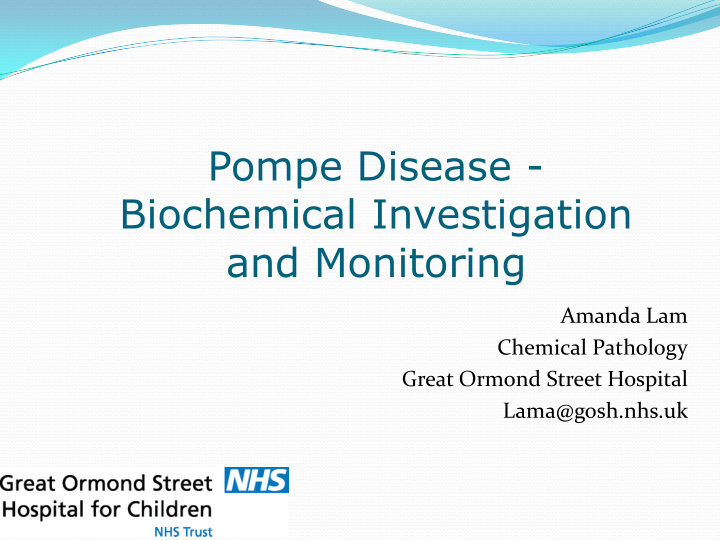



Pompe Disease - Biochemical Investigation and Monitoring Amanda Lam Chemical Pathology Great Ormond Street Hospital Lama@gosh.nhs.uk
Glycogen Metabolism Cell Glycogen Lysosome Branching enzyme Phosphorylase Glycogen synthase Debrancher enzyme -Glucosidase UDP-Glucose 1-6-glucosidase Glucose Glucose-1-P UTP Glucose Glucose-6-P Amylase Cytosol Glc 2-7
The location of glucosidase enzymes in the cell Neutral α -glucosidase pH7 Maltase-glucoamylase Lysosomal acid α -glucosidase (GAA) pH3.8 + acarbose Enzyme activity + Measured at pH 3.8
8 week cut-off £0 Very Clear information required, including request for Pompe ! Good Quality blood spots – essential – otherwise rejection ! 4-methylumbelliferyl -D-glucoside
Fluorimetric GAA Assay: 4-methylumbelliferyl -D-glucoside 4-MU GAA 4-MU -D-glucoside Glucose pH 3.8 tGAA Maltase-glucoamylase: Interfering Enzyme 4-MU MGA 4-MU -D-glucoside Glucose pH 3.8
Fluorimetric GAA Assay: 4-methylumbelliferyl -D-glucoside 4-MU GAA 4-MU -D-glucoside Glucose pH 3.8 Maltase-glucoamylase: Interfering Enzyme 4-MU Inhibition with MGA 4-MU -D-glucoside Acarbose Glucose pH 3.8
Fluorimetric GAA Assay Potential false positives due to specimen deterioration Correction for specimen deterioration: Ratio of GAA/tGAA (+/- acarbose) Measurement of other control enzymes Neutral α -glucosidases: Control Enzyme 4-MU NAG 4-MU -D-glucoside Glucose pH 7
Brief protocol of the DBS Pompe assay Extract enzyme from blood spot with water Set up using the Tecan Robotic pipetting station the three assay condition in a 96 well plate All wells contain substrate and either: pH 3.8 buffer + acarbose pH 3.8 buffer pH 7.0 buffer Add sample to test wells to start the reaction and add sample to blank wells after the reaction has terminated. After 20 hours incubation, stop reaction. Set up a calibration curve then read fluorescence.
DBS 4MU-GAA Assay Ratio +/- Acarbose 1.00 0.90 0.80 0.70 Ratio + / - acarbose 0.60 0.50 0.40 0.30 0.20 0.10 0.00 Control Obligate Infantile Adult onset n = 92 n = 6 n=7 Heterozygote n = 2 Pompe n = 13
DBS 4MU-GAA Assay. Ratio pH7.0 / pH3.8 + acarbose 300 Pompe ratio pH7.0 / pH 3.8 +acarbose 250 200 150 100 50 Unaffected 0 0.00 0.20 0.40 0.60 0.80 1.00 ratio + / - acarbose Control Obligate heterozygote Infantile Pompe Adult Onset Pompe
Pompe Disease – Post DBS Investigations Pseudodeficiency - Follow up testing required Vacuolated lymphocytes Urine tetrasacharride (Glc 4 ) Mutation analysis
Vacuolated Lymphocytes • Range of metabolic diseases lead to cytoplasmic vacuolation • Pompe Disease • Less frequently seen in adult form Anderson et al., 2005
Tetrasaccharide (Glc 4 ) as a Biomarker for Pompe Disease Glc 4 : from glycogen 70 Response 60 Pompe 50 Control 40 30 20 10 0 10 20 30 40 50 • Urine Glc 4 reflects clinical response to treatment ? An et al. (2005) Molec Genet Metab 85, 247.
Urine Tetrasaccharide in Pompe Disease 300 Glc4 umol/mmol creatinine 200 100 On ERT 0 Pompe Patients Controls Pseudodeficiency
Urine Tetrasaccharide in Pompe Disease – Response to ERT Patient 2 70 60 50 Glc4 umol/mmol creatinine 40 30 20 10 0 Pre-treatment Post-treatment (1 DAY) Post-treatment (2 WKS)
CRIM Analysis Cross-reacting immunologic material CRIM +VE patients tend to show better clinical response to ERT Klinge et al 2005, Amalfitano et al 2001, Kishani etal., 2010
CRIM Analysis Currently detection of CRIM is in cultured fibroblasts by Western blotting Only available in a few laboratories world wide Long TAT: fibroblasts required (6 - 8 weeks to grow to confluence) In Development – CRIM analysis in white cells
Immune Modulation Mendelsohn et al., 2009
Pompe – Diagnosis & Monitoring Enzymology Vacuolated Lymphocytes Genetics Tetrasaccharide (CRIM)
Acknowledgements Katie Bainbridge Vicki Manwaring Helen Prunty Derek Burke Simon Heales Staff in the Enzyme Unit at Great Ormond Street Hospital Genzyme
Recommend
More recommend